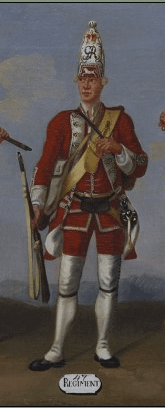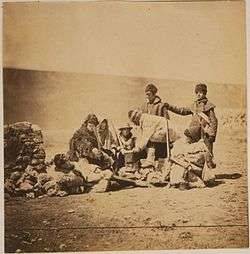47th (Lancashire) Regiment of Foot
| 47th (The Lancashire) Regiment of Foot | |
|---|---|
| Active | 1741–1881 |
| Country |
|
| Branch |
|
| Size | One battalion (two battalions 1794–1795; 1803–1815) |
| Garrison/HQ | Fulwood Barracks, Lancashire |
| Nickname(s) |
The Cauliflowers, The Lancashire Lads, Wolfe's Own |
| Engagements |
Jacobite rising French and Indian War American Revolutionary War Napoleonic Wars Third Anglo-Maratha War First Anglo-Burmese War Crimean War |
The 47th (Lancashire) Regiment of Foot was an infantry regiment of the British Army, raised in Scotland in 1741. It served in North America during the Seven Years' War and American Revolutionary War and also fought during the Napoleonic Wars and the Crimean War. Under the Childers Reforms it amalgamated with the 81st Regiment of Foot (Loyal Lincoln Volunteers) to form the Loyal Regiment (North Lancashire) in 1881.
History
Formation and early service


The regiment was raised in Scotland by Colonel Sir John Mordaunt as Sir John Mordaunt's Regiment of Foot in 1741.[1] The regiment was sent to Scotland and joined the forces of Sir John Cope who were defeated by the Jacobites at the Battle of Prestonpans in September 1745 during the Jacobite rising.[2] The regiment then took part in the defence of Edinburgh Castle.[2] It was ranked as the 58th Regiment of Foot in 1747 but re-ranked as the 47th Regiment of Foot in 1751.[1]
North America

The regiment was deployed to Nova Scotia, under the command of Colonel Peregrine Lascelles, in 1750 for service in the French and Indian War.[3] It took part in the Battle of Fort Beauséjour in June 1755 and the Siege of Louisbourg in June 1758.[4] At Louisbourg, where it fought bravely under General James Wolfe, it earned the nickname "Wolfe's Own".[2] The regiment then took part in the successful attack at the Battle of the Plains of Abraham in September 1759 and the defeat at the Battle of Sainte-Foy in April 1760.[2] The regiment returned home in 1763.[3]
The regiment arrived in North America in New Jersey in 1773 for service in the American Revolutionary War.[3] It took part in the Battles of Lexington and Concord in April 1775 and the Battle of Bunker Hill in June 1775 and the Battles of Saratoga in September 1777.[2] The main body of the regiment was interned as part of the Convention Army and did not return home for another six years.[2] In 1782 the regiment was given a county distinction when it was given the title the 47th (The Lancashire) Regiment of Foot.[1] In 1791 the regiment was sent to the West Indies where it was garrisoned during much of the French Revolutionary Wars.[3] In 1794 a second battalion was raised in Norfolk but was disbanded soon afterwards.[1]
Napoleonic Wars

In 1803 a second battalion was raised again and the following year deployed to Ireland.[5] In 1806 the 1st battalion arrived in the Cape of Good Hope to undertake garrison duties in the territory captured from the Dutch.[3] In early 1807 the 1st battalion embarked on the Second invasion of the River Plate under the leadership of Sir Samuel Auchmuty: it saw action at the Battle of Montevideo in February 1807 and Second Battle of Buenos Aires in July 1807.[2] The battalion was deployed to India in 1808 and the following year its flank companies took part in an expedition to the Persian Gulf.[3]
Meanwhile, the 2nd battalion was deployed to Gibraltar in 1809 and to Portugal in 1811 for service in the Peninsular War.[5] The battalion took part in the Battle of Barrosa in March 1811 and the successful Siege of Tarifa in December 1811.[2] The battalion was victorious at the Battle of Vitoria in June 1813 and took part in the successful but bloody Siege of San Sebastián in August 1813.[2] At San Sebastián the battalion lost 17 of its 22 officers and almost half the other ranks.[2] The battalion then crossed the River Bidasoa and pursued the French Army into France fighting at the Battle of the Nive in December 1813 and taking part in the Battle of Bayonne in April 1814 before returning home and being disbanded at Portsmouth.[5]
The Victorian era


In 1817 the regiment was deployed to India and took part in the Third Anglo-Maratha War helping to defeat the Pindaris.[2] It returned to the Persion Gulf in December 1819 to combat piracy off the shores of Ras al-Khaimah and was sent to Burma in 1824 for service in the First Anglo-Burmese War:[2] it formed part of an army which advanced up the River Irrawaddy to the Kingdom of Ava before returning to India in 1826 and embarking for England in 1829.[3]
The regiment was posted to the Ionian Islands in 1850 and to Malta in 1853 before landing at Calamity Bay in September 1854, as part of the 2nd Division, for service in the Crimean War.[2] The regiment took part in the Battle of Alma in September 1854 and the Battle of Inkerman in November 1854 as well as the Siege of Sevastopol in winter 1854.[2] The regiment returned to Malta in 1856 and to England in 1857.[3]
The regiment returned to Nova Scotia in 1861 to reinforce Canada's defences during tension with the United States arising from the Trent Affair.[2] It then helped defend Canada against Irish-American ex-soldiers during the Fenian raids in 1866.[2] The regiment then went to Barbados in 1868 before landing in Ireland in 1870.[3]
As part of the Cardwell Reforms of the 1870s, where single-battalion regiments were linked together to share a single depot and recruiting district in the United Kingdom, the 47th was linked with the 81st Regiment of Foot (Loyal Lincoln Volunteers), and assigned to district no. 12 at Fulwood Barracks in Lancashire.[6] On 1 July 1881 the Childers Reforms came into effect and the regiment amalgamated with the 81st Regiment of Foot (Loyal Lincoln Volunteers) to form the Loyal Regiment (North Lancashire).[1]
Battle Honours
Battle honours won by the regiment were:[1]
- Burmese Wars: Ava
- Peninsular War: Tarifa, Vittoria, San Sebastian, Peninsula,
- Crimean War: Alma, Inkerman, Sevastopol
- Louisburg, Quebec 1759 (awarded to successor regiment, 1882)
- Nive (awarded to successor regiment, 1910)
Victoria Cross
After the inception of the Victoria Cross (VC) in 1856 Private John McDermond was awarded the only VC of the regiment for his actions in saving a wounded Colonel during the Battle of Inkerman.
Colonels
Colonels of the regiment were:[1]
- 1741–1743: Gen. Sir John Mordaunt, KB
- 1743–1771: Gen. Peregrine Lascelles
- The 47th Regiment of Foot - (1751)
- 1771–1790: Gen. Sir Guy Carleton, 1st Baron Dorchester, KB
- The 47th (Lancashire) Regiment - (1782)
- 1790–1794: Lt-Gen. Sir Adam Williamson, KB
- 1794–1807: Gen. William Dalrymple
- 1807–1813: Gen. Hon. Richard Fitzpatrick
- 1813–1835: Gen. Hon. Sir Alexander Hope, GCB
- 1835–1847: Gen. Sir William Anson, 1st Baronet, KCB
- 1847: Lt-Gen. Sir Harry George Wakelyn Smith, Bt., GCB
- 1847–1854: Lt-Gen. Thomas Dalmer
- 1854–1865: Gen. Sir James Shaw Kennedy, KCB
- 1865–1867: Gen. Sir Charles Thomas van Straubenzee, GCB
- 1867–1875: Gen. John Patton
- 1875–1878: Gen. Sir William O'Grady Haly, KCB
- 1878–1881: Gen. Sir William Sherbrooke Ramsay Norcott, KCB
References
- 1 2 3 4 5 6 7 "47th (the Lancashire) Regiment of Foot". regiments.org. Archived from the original on 11 October 2007. Retrieved 14 July 2016.
- 1 2 3 4 5 6 7 8 9 10 11 12 13 14 15 16 Downham, John. "The 47th (Lancashire) Regiment of Foot". Lancashire Infantry Museum. Duke of Lancaster's Regiment.
- 1 2 3 4 5 6 7 8 9 "47th Regiment of Foot: locations". Regiments.org. Archived from the original on 24 October 2007. Retrieved 31 December 2016.
- ↑ "Nicholas Cox". Dictionary of Canadian Biography. Retrieved 30 December 2016.
- 1 2 3 "2nd Battalion, 47th Regiment of Foot". Regiments.org. Archived from the original on 8 November 2007. Retrieved 31 December 2016.
- ↑ "Training Depots". Regiments.org. Archived from the original on 10 February 2006. Retrieved 16 October 2016.
Further reading
- Purdon, Henry (1907). An historical sketch of the 47th (Lancashire) Regiment: And of the campaigns through which they passed. Guardian Printing Works.